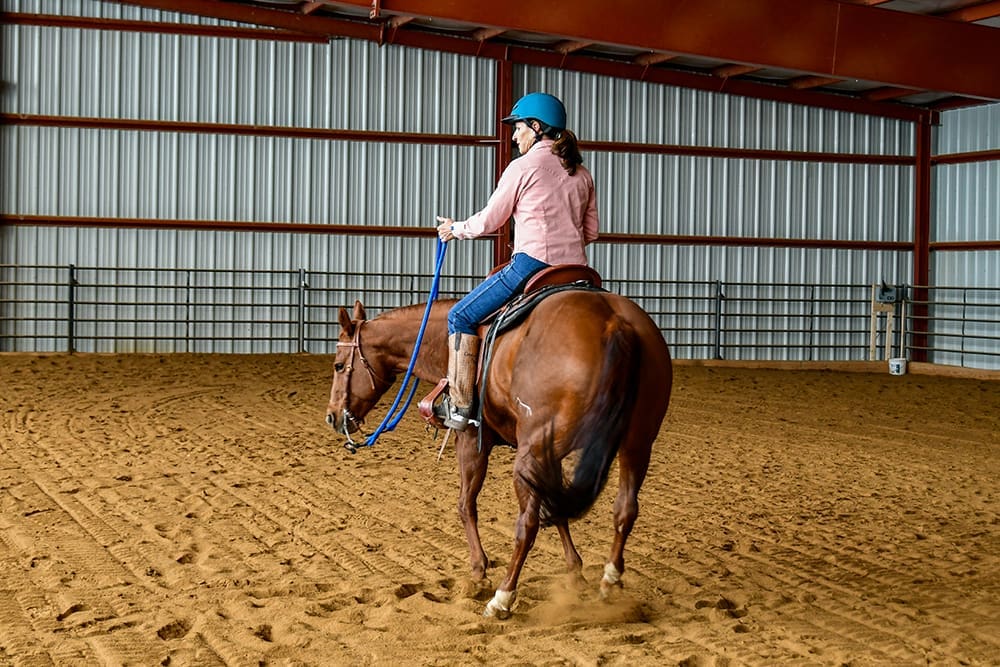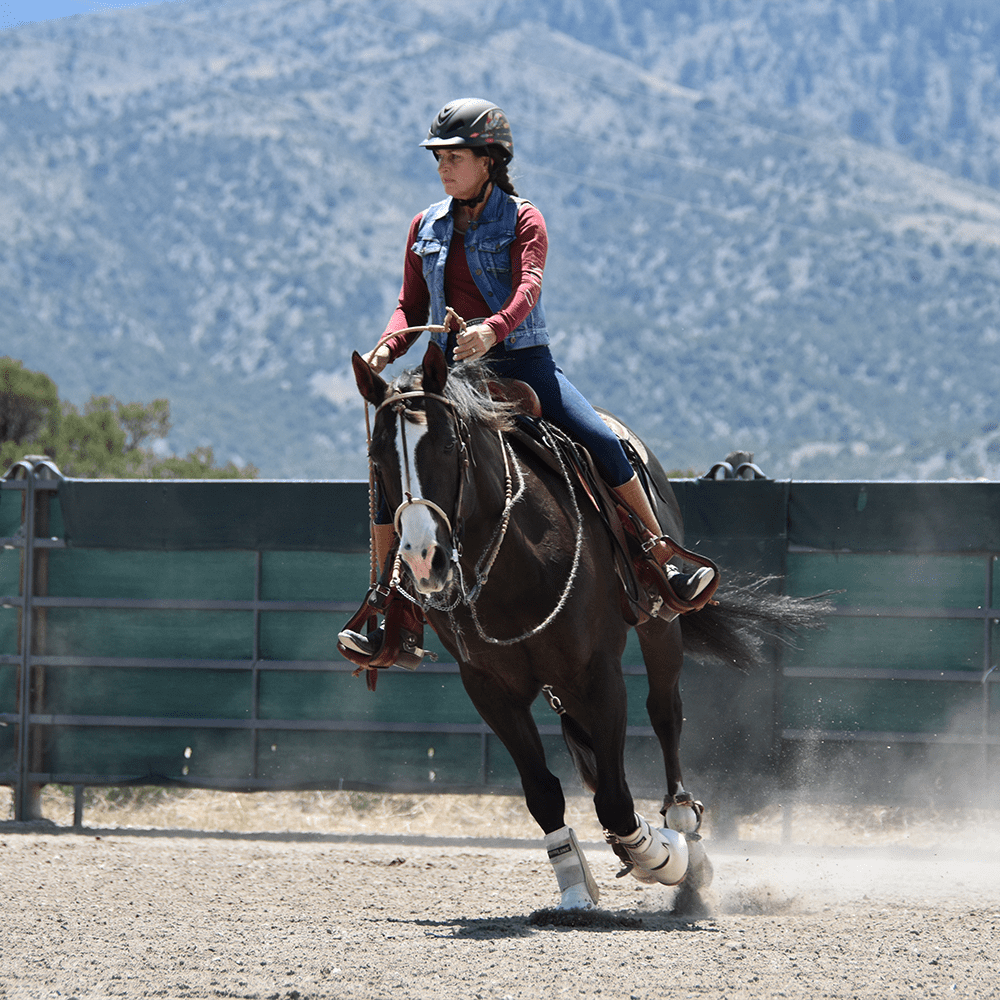Question Category: Building a Better Relationship
Question: Hi Julie,
I am a beginning rider, and have been taking lessons twice a week for about three months now. I have wanted to learn to ride since I was a little girl so this is a dream come true for me (I am 37 now). Initially I was very nervous approaching the horses, but more frequent visits have helped. I’m no longer afraid to get on the horse, but after we’ve walked around the ring a couple of times the horse will start testing me (either that or I’m not giving good cues but she parks at the barn and sidesteps across the ring). I end up yanking on the reins to get her back on track. Then I get tense and the whole thing makes me frustrated and I want to give up. I don’t want to jerk the horse around by the mouth to teach her who is boss but I can’t make her do what I want if I don’t. She is a 9-year old mare and an experienced trail horse. I want to move to faster gaits, but I can’t even get her to trot around in a circle. The men I ride with are naturals and don’t understand why I can’t just get on and ride. I can’t just “get on and ride” because I know I can’t control the horse and that makes me very anxious. I know if I could gain confidence through experience I could relax because then I would feel safer, but I can’t do that if I have to fight the horse every time. I wrote to you because I have read many of the articles on your web site and I think you are brilliant. I hope you can help me realize my dream of cantering across a field unafraid. Thank you so much.
Rachel
Answer: Rachel,
You have a lot of different issues in your question and they are all very common issues that beginners everywhere are dealing with. I will attach another Q&A that I just wrote along the same lines (Gate Gravity), which may help you with your issues of control.
Without fail, the biggest mistakes I see people make when having control issues with a horse is two things that come instinctively to the rider but are the worst things you could do for the horse and only exacerbates the problem. The mistakes are:
1. Pulling back with both reins at the same time,
2. Turning the horse in the direction he wants to go and then circling him back,
When the rider feels like she is losing control of the horse, she instinctively pulls back with both reins, sometimes with a turning motion. When the horse feels that much pressure on his mouth, he locks up, leans into the bit and generally does the opposite of what you want– if you want him to slow down, he speeds up, if you want him to turn right, he turns left. It is known as “running through the bridle” or “running through the shoulder” and are common responses of the horse when he feels steady and unrelenting pressure on both sides of his mouth at the same time. This horse becomes very defensive of his mouth and sticks his nose out and begins to feel to the rider like he has a steel pipe down the middle of his neck.
Sadly, this horse is often labeled “hard mouthed,” like it is his fault. In my opinion there is no such thing as a hard mouthed horse and I have never yet found a horse that could not be rehabilitated to become a very light and responsive horse, and we get a lot of these horses in training. Also, I have seen many school horses learn that all they need to do is get the rider riled up emotionally so she freezes up with both reins and then the horse knows he can have his way with the rider and go where he wants. When you lock up into a tug o’ war with the horse, he will always win because it becomes a pound-for-pound race.
Always try to use your reins one at a time and in rhythm with the horse, in a pulsating or dynamic fashion, not a static white-knuckle pull; always be quick to offer the release. Learn to ride through problems, not lock up on the reins. Your horse mirrors your emotions so when you feel frustrated, you horse is feeling the same thing. Try to keep your emotions in check. Some horses learn that all they have to do is challenge you a little so that you get emotional and lock up and then they know they can do anything they want.
When turning right, first slide your hand down the right rein, then slowly pick up on the rein toward your chest, releasing with the opposite rein. The slower you move your hands, the softer the horse will become. The outside rein should be totally slack– do not try to turn with that rein too, because as soon as you start pulling with both reins, the horse stiffens and you lock up. Keep the horse moving forward in the turn by reaching forward with your hands and closing both your legs on the horse’s barrel in a pulsating fashion. Don’t pull BACK on the rein to turn, that will interfere with his forward motion; gently lift the rein up or to the side.
The second problem is that when the horse becomes nappy and will not turn in the direction you are asking, most riders will give up before the horse does and turn the horse the other way, planning to circle back around to that spot you wanted to go to begin with. Although it often works long enough for you to get the horse positioned where you wanted him to begin with, you have just trained your horse to be disobedient by letting him turn the way he wanted to go and he most certainly will do it again. In the horse’s mind, he only knows he got to turn the way he wanted; he will not make the association of having to go back to where you wanted because too much time has elapsed in his brain. He was rewarded for refusing the rider.
The other problem you mention is with confidence on your part, which exacerbates the control problems that you have with your horse. This is a huge issue and I guarantee there are thousands of people out there that know exactly how you feel. There is an article on my website on dealing with fear that should be helpful for anyone. There is also a book coming out soon called “Ride with Confidence!” in which I am one of five contributing authors. The book is being published in England and should be out this fall and I think it is going to be a good one. I’ll be sure to publish it in my newsletter when the book is available.
One of the most important components when dealing with fear is to surround yourself with understanding, empathetic and supportive people that can help you reach your goals. Also, you should pick the company that you ride with carefully. If you do, you’ll gain confidence more quickly, with more good experiences. I hope you can find a riding instructor or friend to help you work through this control problem. Read through all my Q&As because you’ll probably find other issues that relate to the problems you are having. Don’t worry, you’ll get there, just be persistent.
Julie Goodnight, Clinician and Trainer
Copyright ©Julie Goodnight 2000. All Rights Reserved. No part of this website may be reproduced without owner’s express consent.



